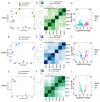Adaptive Expression and ncRNA Regulation of Genes Related to Digestion and Metabolism in Stomach of Red Pandas during Suckling and Adult Periods
- PMID: 38929414
- PMCID: PMC11200446
- DOI: 10.3390/ani14121795
Adaptive Expression and ncRNA Regulation of Genes Related to Digestion and Metabolism in Stomach of Red Pandas during Suckling and Adult Periods
Abstract
Red pandas evolved from carnivores to herbivores and are unique within Carnivora. Red pandas and carnivorous mammals consume milk during the suckling period, while they consume bamboo and meat during the adult period, respectively. Red pandas and carnivorous mammal ferrets have a close phylogenetic relationship. To further investigate the molecular mechanisms of dietary changes and nutrient utilization in red pandas from suckling to adult, comparative analysis of the whole transcriptome was performed on stomach tissues from red pandas and ferrets during the suckling and adult periods. The main results are as follows: (1) we identified ncRNAs for the first time in stomach tissues of both species, and found significant expression changes of 109 lncRNAs and 106 miRNAs in red pandas and 756 lncRNAs and 109 miRNAs in ferrets between the two periods; (2) up-regulated genes related to amino acid transport regulated by lncRNA-miRNA-mRNA networks may efficiently utilize limited bamboo amino acids in adult red pandas, while up-regulated genes related to amino acid degradation regulated by lncRNAs may maintain the balance of amino acid metabolism due to larger daily intakes in adult ferrets; and (3) some up-regulated genes related to lipid digestion may contribute to the utilization of rich nutrients in milk for the rapid growth and development of suckling red pandas, while up-regulated genes associated with linoleic acid metabolism regulated by lncRNA-miRNA-mRNA networks may promote cholesterol decomposition to reduce health risks for carnivorous adult ferrets. Collectively, our study offers evidence of gene expression adaptation and ncRNA regulation in response to specific dietary changes and nutrient utilization in red pandas during suckling and adult periods.
Keywords: digestion and metabolism; ferret; gene expression adaptation; ncRNA regulation; red panda.
Conflict of interest statement
The authors declare that they have no competing interests.
Figures






References
-
- Lillycrop K.A., Slater-Jefferies J.L., Hanson M.A., Godfrey K.M., Jackson A.A., Burdge G.C. Induction of altered epigenetic regulation of the hepatic glucocorticoid receptor in the offspring of rats fed a protein-restricted diet during pregnancy suggests that reduced DNA methyltransferase-1 expression is involved in impaired DNA methylation and changes in histone modifications. Br. J. Nutr. 2007;97:1064–1073. - PMC - PubMed
-
- Ehara T., Kamei Y., Yuan X., Takahashi M., Kanai S., Tamura E., Tsujimoto K., Tamiya T., Nakagawa Y., Shimano H., et al. Ligand-activated PPARalpha-dependent DNA demethylation regulates the fatty acid beta-oxidation genes in the postnatal liver. Diabetes. 2015;64:775–784. doi: 10.2337/db14-0158. - DOI - PubMed
Grants and funding
LinkOut - more resources
Full Text Sources

